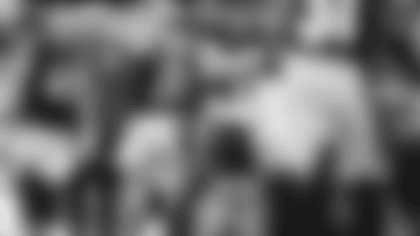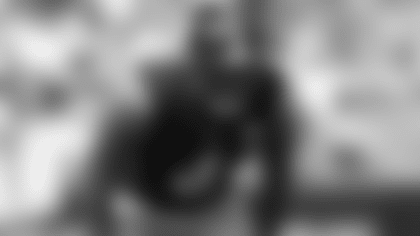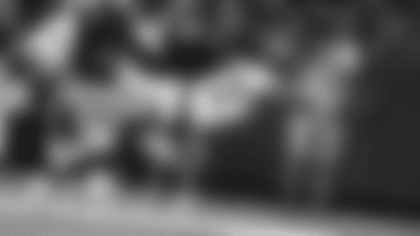Q. During your news conference on Tuesday, you said that today's opponent, the Denver Broncos, will play to their environment. What does playing to their environment mean, and how do the Broncos do that?
A. They started last week on the road, as we did, and there's a certain set of challenges that come with that. Today they've got the comforts of their home venue, their reputation is real in terms of the crowd noise. I'd imagine their defense is going to use that to their advantage, particularly in one-dimensional passing circumstances. They're going to be in a blitz posture. They're going to stress our offensive line. We've got a rookie center, we've got a young, inexperienced guard, we're in their venue, and that's the first thing that comes to mind when I think about the advantages of that. And then on the offensive side of the ball, everything is at your disposal when you're working in the confines of your own venue. If they choose to change the pace and go no-huddle, they're capable of doing that. You can communicate at the line of scrimmage when you're in those scenarios. People are more comfortable trying things in their home venue, gadgets and things of that nature, than they are on the road.
Q. Whenever the words Denver and environment are put together, one thing that comes to mind is the altitude. Chuck Noll believed athletes needed several days of exposure to altitude to become accustomed to it, and so the best travel plan was to arrive in the city the day before the game like a normal road trip. Do you share that?
A. I think those discussions are less relevant today. Technology has minimized some of that. These guys train with devices that restrict their oxygen intake in the offseason, for example, and so there's so many mechanisms at their disposal to prepare them, not only this week, but over the course of the whole 12 month calendar in terms of how they train. Restricted oxygen is just a routine component of training these days, and I think it just prepares them for some of those scenarios that used to be more problematic for us as a collective.
Q. From a football 101 perspective, what are the advantages and disadvantages of having the quarterback under center vs. in the shotgun?
A. Under center you can do a lot more things in terms of play concepts, particularly in the run game. Your play-action pass is more effective from under center. It is very difficult to get that downhill attack feel that usually causes linebackers to suck up toward the line of scrimmage when you're doing play-action pass out of shotgun. And so it's some of those nuances – the amount of plays, particularly in the run game that are at your disposal. There's a limited number that are at your disposal in shotgun, and then there's a little bit lost in terms of the feel of play-action pass.
Q. Because most high schools and colleges now run their offenses with the quarterback in the shotgun, do quarterbacks coming into the NFL lack the skill and know-how to execute under center?
A. It's not only the quarterbacks, but it's also the centers. And you become what you repeatedly do. There is a muscle-memory component to skill development, and it is not unreasonable in today's game to have a center and a quarterback having played all the way to the professional level without having a lot of exposure to center-quarterback exchanges. It's just a function of today's game. A lot of offenses operate exclusively out of shotgun or pistol, and a lot of colleges do as well. And so that's just a component of today's game that I really don't make a big deal out of to be honest with you. These are top flight athletes at the professional level. You present something new to them; they learn it, and they make it a non-issue. It's like most college punters don't double as holders because there are 110 people on the roster in college. Most punters you have to teach to hold once they get to the NFL. But if they're top-notch caliber athletes, it's a pretty fluid process.
Q. How would being in shotgun 100 percent of the time impact the other positions on offense – the linemen, the eligibles, the running backs?
A. Oftentimes shotgun comes with offensive linemen in a two-point stance, just in terms of a structure. And so there are a lot of unintended consequences, or secondary consequences of playing out of that structure. If you're playing out of that structure exclusively, you do probably more pass than run. The pass sets up your run. The splits are usually dictated by that approach to business. The type of plays that you run, a lot of zone scheme running, for example, as opposed to gap scheme runs. We could go on for days about the ramifications for all parties involved when you choose that to be your structure. But it's just a component of our business. It's no different than having a 4-3 vs. 3-4 discussion on defense. It's really not a big deal. It's just how you choose to go about your business.
Q. A penalty we saw more of during Kickoff Weekend was illegal formation when an offensive tackle was ruled to have lined up in the backfield. What is the standard there, between what's legal and what will draw a penalty flag?
A. You have to break the waistline of the center. If you're an offensive lineman, that's the general standard. Your helmet has to break the waistline of the center. They challenge that from time to time, particularly in one-dimensional passing moments. A tackle who's facing a premier edge rusher will try to get an advantage, and usually that's where the discussion lies. Very rarely do you see that penalty being called on first or second downs. Generally, it's a one-dimensional passing circumstance, and a guy is facing a premier rusher, and he's trying to gain an edge. And his helmet might not be breaking the waistline of the center. That's the general discussion.
Q. Is that a new point of emphasis for the officials, because I don't remember that being called very much, if at all?
A. Certain things go down at the early portions of the season in the NFL. I'm not going to call it an agenda, then that would make me a conspiracy theorist. But certain things go down at the beginning of the season that kind of gets everyone's attention and everyone falls in line. I'll leave it at that.
Q. Another stat that jumped out from Kickoff Weekend was that placekickers were successful on 21-of-23 field goal attempts from 50-plus yards. Does that level of consistent accuracy impact in-game strategy, either in terms of attacking or defending?
A. Certainly, it does. But I think that's not a secret. This time of year, there's no component of fatigue that could affect that, the wear and tear of the journey, if you will. I'd imagine that number will be lower over the second half of the season. But also there are just a number of pristine environments this time of year, whether it's indoors or whether it's nice weather outdoors in September. As you get into October and November, weather conditions become a factor, and the cumulative fatigue component of the journey becomes a factor, which makes 50-plus yard field goals more problematic in terms of decision making and the actual kicking.
Q. Bo Nix will start at quarterback today for the Broncos. Would you classify him as a mobile quarterback who is looking to buy time to make throws down the field, or is he a running quarterback for whom there will be designed plays called to attack a defense with his running?
A. In terms of his draft profile, I characterized him as a mobile guy. But I saw some stuff in Week 1 in terms of what he was able to do and what they were able to do where that's probably evolving. The thing that I have to acknowledge is a one game body of work is a small sample size, and so we are discovering that, and really, probably the Denver Broncos are discovering that. If we're all being truthful with ourselves. This time of year we're still discovering a lot of things about our opponents and about ourselves. We're hardening up divisions of labor. We're hardening up and developing personalities and things that are non-negotiable. I think that's just a component of the early portions of the journey that is the season. I've been in it long enough to see it from that perspective. Sometimes younger and more inexperienced guys are ready to die on hills too early in this journey, when it's an evolving and developing thing.
Q. In terms of his running style, does Nix have any Josh Allen in him?
A. Josh Allen is an alien. Bo Nix is effective. I'm not ready to put him in the alien category. Hopefully my opinion doesn't change after this football game.
Q. What are some of the characteristics of a Sean Payton offense?
A. You know, Sean utilizes a variety of personnel groups, and that just speaks to his experience. A lot of the younger coordinators, they thrive on pace. And when you thrive on pace, then obviously that limits your personnel usage. Sean Payton has been around. He's like Jon Gruden. He's from that generational play-caller where personnel and specialization kind of characterizes them differently than Sean McVay and Mike McDaniel and guys like them, who are from a younger generation where pace is king. Specialization and personnel is king for Sean Payton's generation, obviously which I'm of a part of.
Q. Earlier in the week, you signed punter Corliss Waitman, and you said he developed as a holder during his time with the Steelers. Can you expand on that? And did Chris Boswell impact that process?
A. As I mentioned earlier in our conversation, in college circumstances oftentimes punters don't hold because of the number of people available to college coaches. It is a dual job in the NFL because of talent scarcity. There are a limited number of people, and so we taught him how to hold. And obviously him learning how to hold here, Boz was a major component of that. And so I would imagine that's pretty comfortable for Boz, considering he was a part of (Waitman's) growth and development process in that area. And make no mistake, not only is it the exploits of Boz when we send our field goal unit out there, but there's a snap-hold-kick component of it that's a major component of consistency and operation as well.
Q. How does the kicker help a guy learn how to be a holder?
A. By just talking to him about what he values. You know, the ball could be held at a variety of angles, or upright. Some kickers prefer a ball to be up and down. Some want the ball leaning backward, or forward, etc. Some kickers are really sensitive about the space in which you place the ball. And so there are a lot of nuances to the discussion, and really, it's probably different from kicker to kicker. And Boz was able to impose his little nuances on Corliss at a very young age, and I imagine it shaped some of his core values and mechanics as a holder.
Q. Did you consider his mechanics as a holder when you were picking a punter to replace Cameron Johnston?
A. Absolutely. Absolutely.
Q. Is Chris Boswell's opinion a little bit more important in that decision than mostly anybody else but yours?
A. Hey, let's be honest, OK. When you're trying to pick a punter from a bunch of punters who are unemployed, guys are unemployed for a reason. And so there are some shortcomings that all the candidates have. When one of the candidates has an experience with your kicker who was AFC Special Teams Player of the Week last week, then yes, it is a component of the discussion.














